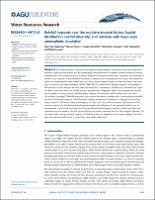| dc.contributor.author | Espinoza, J.C. | |
| dc.contributor.author | Chavez, Steven | |
| dc.contributor.author | Ronchail, Josyane | |
| dc.contributor.author | Junquas, Clémentine | |
| dc.contributor.author | Takahashi, Ken | |
| dc.contributor.author | Lavado-Casimiro, W. | |
| dc.coverage.spatial | Peru | |
| dc.coverage.spatial | Bolivia | |
| dc.coverage.spatial | Andes | |
| dc.date.accessioned | 2021-07-01T16:21:40Z | |
| dc.date.available | 2021-07-01T16:21:40Z | |
| dc.date.issued | 2015-05-11 | |
| dc.identifier.citation | Espinoza, J. C., S. Chavez, J. Ronchail,C. Junquas, K. Takahashi, andW. Lavado (2015), Rainfall hotspotsover the southern tropical Andes:Spatial distribution, rainfall intensity,and relations with large-scaleatmospheric circulation, Water Resour.Res., 51, 3459–3475, doi:10.1002/2014WR016273. | es_PE |
| dc.identifier.uri | https://hdl.handle.net/20.500.12542/1027 | |
| dc.description.abstract | The Andes/Amazon transition is among the rainiest regions of the world and the interactionsbetween large-scale circulation and the topography that determine its complex rainfall distribution remainpoorly known. This work provides an in-depth analysis of the spatial distribution, variability, and intensity ofrainfall in the southern Andes/Amazon transition, at seasonal and intraseasonal time scales. The analysis isbased on comprehensive daily rainfall data sets from meteorological stations in Peru and Bolivia. We com-pare our results with high-resolution rainfall TRMM-PR 2A25 estimations. Hotspot regions are identified atlow elevations in the Andean foothills (400–700 masl) and in windward conditions at Quincemil and Chipir-iri, where more than 4000 mm rainfall per year are recorded. Orographic effects and exposure to easterlywinds produce a strong annual rainfall gradient between the lowlands and the Andes that can reach190 mm/km. Although TRMM-PR reproduces the spatial distribution satisfactorily, it underestimates rainfallby 35% in the hotspot regions. In the Peruvian hotspot, exceptional rainfall occurs during the austral dryseason (around 1000 mm in June–July–August; JJA), but not in the Bolivian hotspot. The direction of thelow-level winds over the Andean foothills partly explains this difference in the seasonal rainfall cycle. Atintraseasonal scales in JJA, we found that, during northerly wind regimes, positive rainfall anomalies pre-dominate over the lowland and the eastern flank of the Andes, whereas less rain falls at higher altitudes. Onthe other hand, during southerly regimes, rainfall anomalies are negative in the hotspot regions. The influ-ence of cross-equatorial winds is particularly clear below 2000 masl. | es_PE |
| dc.format | application/pdf | es_PE |
| dc.language.iso | eng | es_PE |
| dc.publisher | American Geophysical Union | es_PE |
| dc.relation.uri | https://agupubs.onlinelibrary.wiley.com/doi/full/10.1002/2014WR016273 | es_PE |
| dc.rights | info:eu-repo/semantics/openAccess | es_PE |
| dc.rights | Atribución-NoComercial-SinDerivadas 3.0 Estados Unidos de América | * |
| dc.rights.uri | http://creativecommons.org/licenses/by-nc-nd/3.0/us/ | * |
| dc.source | Repositorio Institucional - SENAMHI | es_PE |
| dc.source | Servicio Nacional de Meteorología e Hidrología del Perú | es_PE |
| dc.subject | Rainfall | es_PE |
| dc.subject | Andes | es_PE |
| dc.subject | Lluvia | es_PE |
| dc.subject | Precipitación | es_PE |
| dc.subject | Lluvia | |
| dc.title | Rainfall hotspots over the southern tropical Andes: Spatial distribution, rainfall intensity, and relations with large-scale atmospheric circulation | es_PE |
| dc.type | info:eu-repo/semantics/article | es_PE |
| dc.identifier.doi | https://doi.org/10.1002/2014WR016273 | |
| dc.subject.ocde | https://purl.org/pe-repo/ocde/ford#1.05.09 | es_PE |
| dc.subject.sinia | precipitacion - Clima y Eventos Naturales | |
| dc.type.sinia | text/publicacion cientifica | |
| dc.identifier.url | https://hdl.handle.net/20.500.12542/1027 | |









